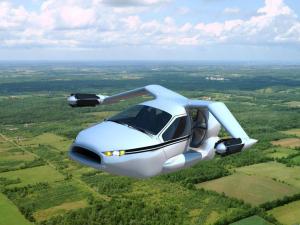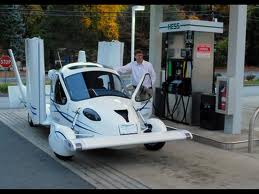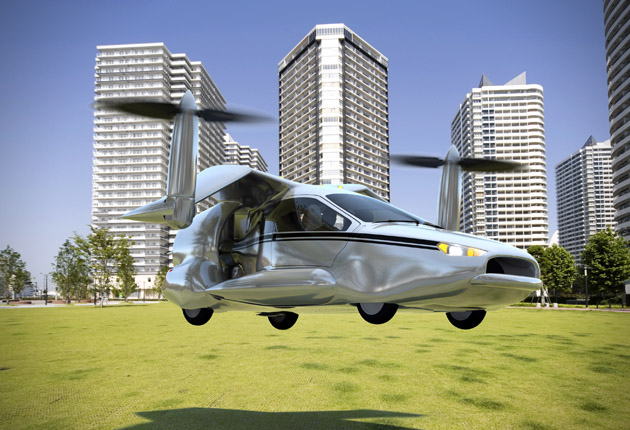One of my readers recently asked me to write about flying cars. I have looked at this technology in the past and considered it of little value as a common mode of transportation. Cars drive on roads. Airplanes take off from private or commercial airports. When you fly you file a flight plan. You don’t do this to drive your car. So if you want to take off from the road you are on in your flying car, what do you do? Call the airport and file a flight plan before jumping into the air? It is the impracticality of the flying car that makes me think it is more a novelty than real, something for a James Bond movie maybe.
But there are those who continue to want to invent such a vehicle. One of them is Terrafugia Inc., whose convertible flying car designs have been around since 2006. The company has the Transition, a two-seat fixed wing convertible aircraft that fits into a your family garage and can be flown out of any airport. Transition flew in 2009. Now a second generation aircraft, dubbed the TF-X is the next step in the company’s long-term plans. TF-X is a fixed wing hybrid electric flying car with room for four passengers.
Specifications for Transition:
- Maximum Flight Speed: 185 kilometers (115 miles) per hour
- Range: 787 kilometers (490 miles)
- Fuel capacity: 87 liters (23 gallons)
- Runway requirement: 518 meters (1,700 feet)
- Capacity: 210 kilograms (460 pounds)
- Fuel consumption at cruise: 18.9 liters (5 gallons) per hour
- On road mileage: 6.7 liters per 100 kilometers or 35 miles per gallon
Specifications for the TF-X:
- Maximum Flight Speed: 360 kilometers (200 miles) per hour
- Range: Approximately 800 kilometers (500 miles)
- Fuel capacity: Unspecified for cruising motor which also recharges the electric powered takeoff and landing rotors
- Runway requirement: 30 meters (100 feet) vertical take off and landing
- Capacity: 420 kilograms (920 pounds)
- Fuel consumption at cruise: Unspecified
- On road mileage: Unspecified
Transition (seen below) is still not certified for flight by the U.S. Federal Aviation Administration but the company has at least 100 customers lined up to purchase. You can watch a test flight here and if interested reserve your own Transition on the website. The only reference I have found for price is around $279,000 U.S.
TF-X (seen in takeoff mode in the artist rendering below) is probably a decade away from commercial launch. Watch a video on YouTube to see what Terrafugia believes represents the future of personal travel. It will probably cost you a cool half million U.S.
Whether practical or not, both of these dual-purpose machines look like they would be a lot of fun!












The most amazing thing about flying car schemes are the people who are ingenious enough to design and build them, but at the same time are stupid enough to suppose there will ever be any significant market for them. Development of any practical flying car awaits the seemingly improbable invention of a thrust system that defies Newton’s third law of motion, and which operates independently of reaction mass. (For every action there must be an equal and opposite reaction). So far, no human has been ingenious enough to make the reactionless thrust system. If a reactionless propulsion system were to be invented, flying cars would rank near the bottom of a long list of potential applications.
The conceptual drawing of the TF-X is preposterously out of scale. As drawn, it’s a lead duck. If two small rotors could produce enough thrust to support a TX-F, they could produce enough thrust to support ordinary helicopters and the Bell Osprey tilt-rotor aircraft. Helicopter rotors are as large as they are because the laws of physics don’t allow them to be smaller.
Len, I am inclined to agree with you that the flying car is a solution in search of a problem. The superficial attraction of course is that you can avoid road congestion for routine travel, since you can hop up and over gravity-bound traffic. But let’s be generous and presume technology advances to the point that the premium for such cars is affordable, they can ascend nearly vertically (so no incremental runway construction) and they are self-navigating and collision-avoiding (so no flight plans required). What is going to make this impractical is the humble parking lot. Since your destination will need relatively close parking (or else what’s the point of speeding over there) and others will want to get there at similar times of day, I would be willing to bet that you end up trading horizontal for vertical congestion. Safety will demand a fair amount of vehicle separation around congested destinations, so plan on waiting in vertical queues. Just imagine how time for that will stretch out as wind speed rises!